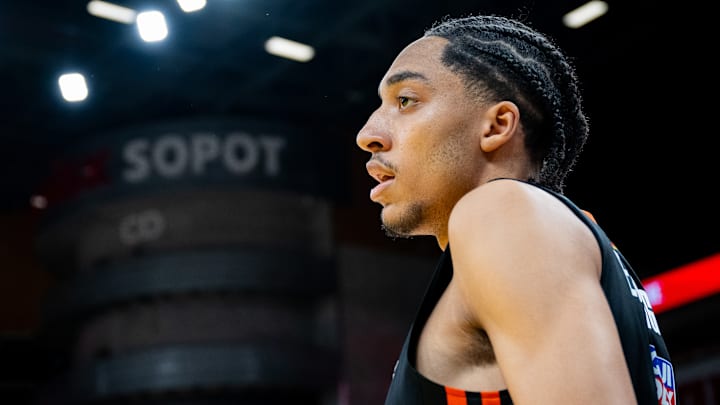There's no team in the NBA more associated with draft picks than the Oklahoma City Thunder.
Despite leading the league with 68 wins and holding a 1-0 series lead in the Western Conference Finals, OKC owns the rights to 15 first-round draft picks in the next four drafts, two of which fall in this June's festivities.
General Manager Sam Presti has made a name for himself in the draft department over his 18 years with the Thunder, selecting five All-Stars and four other All-Rookie team honorees.
In the 2025 NBA Draft, the Thunder own the No. 15 (via Miami), No. 24 (via Clippers), and No. 44 overall pick (Via Atlanta).
With these rights, Presti has the opportunity to add three more special talents to a team looking to contend for the long haul.
Looking at how the Thunder could approach the 2025 NBA Draft
Below are ESPN analysts Jonathan Givony and Jeremy Woo's breakdown of how they believe OKC could operate during next month's event.
- No. 15: Noa Essengue, F - Ratiopharm Ulm (Germany)
- No. 24: Maxine Raynaud, C - Stanford
- No. 44: Jamir Watkins, G - Florida State
In this hypothetical scenario, Oklahoma City walks away with a blend of win-now talents and development projects, similar to the organization's recent drafts.
If this proposed scenario were to come to life, here's how the report card would grade:
Logic behind the Thunder drafting Noa Essengue
Essengue checks the boxes of a typical Thunder pick in the 2020s: multi-positional size, solid ball handling, and physical defense.
In 2024-2025 with Ratiopharm Ulm, he averaged 12.4 points, 5.5 rebounds, and 1.1 assists per game. The 18-year-old is a French native and would join Ousmane Dieng (2022) and Theo Maledon (2020) as recent draftees from the nation.
Similar to Dieng, Essengue has a desirable 6-foot-9, 194-pound frame, having the perfect physical makeup for an NBA forward.
Despite shooting up draft boards in recent weeks, he's still very much labeled as a project player, which is primarily due to his shaky three-point shot and defensive inconsistencies.
On the plus side, Essengue showcased his ability to get to the rim – and the charity stripe – at will this past season.
In 23.7 minutes per game, he attempted 5.6 free throws per game, knocking down 73.0 percent of them. Considering the Thunder ranked 26th in the NBA in free throws attempted per game, Essengue could help boost that number closer to league-average.
Defensively, Essengue's 6-foot-11 wingspan allows him to hound ball-handlers and cause chaos in passing lanes, averaging 1.4 steals per game.
While he's prone to lapses in terms of positioning and scramble-switching, his physical tools are promising enough for an organization to take a swing on him. What better team to take in a raw, high-potential defender than the league's best defensive net rating team?
Grade: A
Logic behind the Thunder drafting Maxine Raynaud
Givony and Woo have yet another Frenchman heading to Oklahoma City in their 2025 mock, this time in the form of Stanford senior Maxine Raynaud.
The 7-footer was relatively late to the game of basketball, having not started playing competitively until 13 years old. Before that, he was focused on being an extremely successful youth swimmer.
By the time his senior year at Stanford came around, Raynaud became a much more polished player, averaging 20.2 points, 10.6 rebounds, and 1.4 blocks per game.
The Thunder's big-man rotation is among the league's best, holding All-Defensive candidate Chet Holmgren, elite roll-man Isaiah Hartenstein, triple-double threat Jaylin Williams, and two-way standout Branden Carlson.
However, with Williams, Holmgren, and potentially Hartenstein's contracts expiring after the 2025-2026 season, Oklahoma City will have some decisions to make when it comes to who they're willing to pay for the long haul.
A solution to potentially losing some of their bigs would be adding Raynaud through the draft, and subsequently signing him to a standard four-year contract.
Raynaud has stood out at the NBA combine, dropping 20 points and 9 rebounds in his first scrimmage. His ability to protect the rim while also spacing the floor (34.7 percent from deep in his senior season) fits the mold of what the Thunder look for in a big man.
While he may not wind up logging consistent rotational minutes, it's important to have depth at the center position if injuries arise – a situation the Thunder were all too familiar with throughout this season.
Grade: B+
Logic behind the Thunder drafting Jamir Watkins
While Jamir Watkins would be the latest selection of the three, that's no reason to count him out.
Sam Presti has selected multiple second-round steals over the course of the recent rebuild, bringing in rotational players like Ajay Mitchell, Jaylin Williams, Aaron Wiggins, and more.
Watkins ran the show during his senior year at Florida State, averaging 18.4 points, 5.7 rebounds, and 2.4 assists per game. The 6-foot-7 wing has good positional size as a ball-handler and was comfortable with the ball in his hands.
In certain regards, he fits right in with core Thunder values – a lanky, switchable defender who can handle the ball and get to the rim at will.
In others, however, it's quite the contrary.
Watkins' three-point shot grew stale over the course of his collegiate career, dipping down to 32.1 percent on 5.2 attempts per game in his senior season. It seems clear that to log consistent minutes for the Thunder, a viable long-range game is a necessity.
Watkins also struggled finishing at the rim, making just 50.0 percent of his layups during his senior season. While he seems to project as a potential spark plug ball handler, he'd have to outdo 2024 draftees Ajay Mitchell and Nikola Topic for that role, which is no doubt a tall task.
Grade: C
